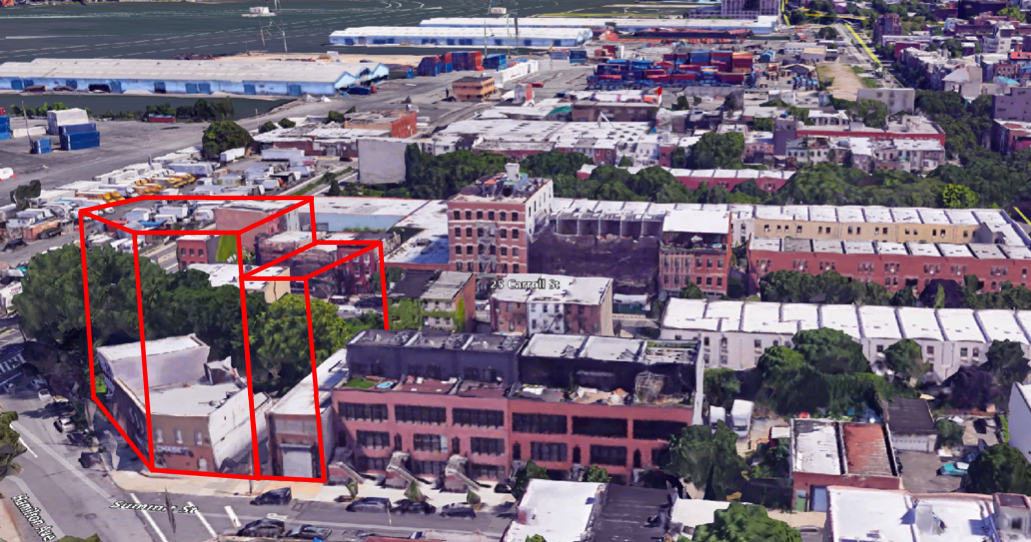Council Member Grapples with 41 Summit Street Rezoning

COLUMBIA STREET WATERFRONT – The 41 Summit Street rezoning application was presented during the NYC City Council Subcommittee on Zoning & Franchises hearing on Wednesday, March 6.

A representative for the developer of 41 Summit Street clarified that the building planned for that site has been changed to five stories instead of the seven stories initially shown in renderings.
The owner of 41 Summit Street filed a ULURP (uniform land use review procedure) zoning map amendment application requesting to change zoning for that parcel, as well as two adjacent parcels, from an M1-1 zoning district (light manufacturing) to an R7A (medium-density residential) / C2-4 (commercial overlay) district which would have allowed for the development of a mixed-use structure that could rise as tall as nine stories.
Brooklyn Borough President Eric Adams, as well as neighbors of the development, felt that R7A zoning was too high and out of context with the low-rise neighborhood and requested that it be scaled down to R6B—to keep the building height consistent with the neighborhood. The NYC Department of City Planning (DCP) amended the zoning request from R7A to R6A which would allow eight-story buildings to rise.
DCP decided on R6A instead because R6B “is not within scope of this application because it would reduce the available community facility FAR [floor area ratio] below what is currently available under M1-1,” explained Catie Ferrara during a February 11 City Planning Commission review session for the 41 Summit Street proposal. The City Planning Commission voted to approve the R6A zoning for the project on February 27.
Back in November, Community Board 6 voted to disapprove the proposal as part of the ULURP process. Click here to see the community board’s letter addressed to the City Planning Commission Chair regarding the decision. Following Wednesday’s hearing there will be a vote by the City Council zoning subcommittee [April 2], followed by a full City Council vote.
During Wednesday’s hearing, Council Member Brad Lander repeatedly asked the developer representative what public benefits the project would include. The ability to provide additional housing units and to develop residential-use instead of “potential noxious commercial sites” was the response. Lander said that the developer’s argument for R6A zoning was “poor” and that the only “benefit” the rezoning would bring to the neighborhood would be a few additional market rate apartments with no guarantee of any affordable housing units.
“I feel genuinely torn about this application,” Lander said. “The easy thing for me to do would be to be mindful of the fact that it is unanimously opposed by its neighbors and to just have told you from the beginning that I’m not going to support it. I believe that we need additional density in the city. I believe we need more housing and it’s hard to do everywhere, so I wanted to…listen and to hear the proposal, but I just have to be honest, the compelling case of public benefits for the additional density that you’re asking the community to support are pretty thin.”
More than 20 community members testified at the hearing to oppose the project. One speaker brought testimony from another 27 residents who were unable to attend. Reasons for their opposition included the shadows the buildings would cast on the Backyard Community Garden and residents’ backyards and the lack of affordable housing in the proposal as well as any other community benefits.
A few renters in the neighborhood noted that they live in the area because of the affordability and that the project’s market rate apartments would make rents increase, creating an “affordable housing loss with none gained,” said resident Katarina Jerinic.
“I worry honestly about what we have here today because I feel like on the one hand we do have a proposal with insufficient public benefit to merit the request and on the other hand, an instinct that, mapped citywide, prevents us from being the city that we need to be…. I think it’s on all of us,” Lander said at the close of the hearing.
“I really think we have more responsibility to see the ways in which those impulses writ large prevent us from building the inclusive city that we want to have because this is not a neighborhood for everyone. The beautiful garden and beautiful neighborhood we have are not nearly as inclusive as [they] need to be and the set of decisions we make together keep it that way. That does not mean this application merits support, but it’s hard.” the Council Member added.




